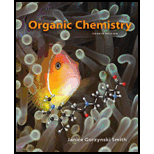
Concept explainers
(a)
Interpretation: The Condensed formula of the given molecule is to be converted to Lewis structure.
Concept introduction: The Condensed formula of the molecules represents all the atoms but not the two-electron bond. Atoms which are bonded together are usually drawn next each other. Parentheses indicate that the similar groups that are bonded to the same atom. Lone pairs of the atoms are not shown in a condensed formula.
(b)
Interpretation: Condensed formula of the given molecule is to be converted to Lewis structure.
Concept introduction: The Condensed formula of the molecules represents all the atoms but not the two-electron bond. Atoms which are bonded together are usually drawn next each other. Parentheses indicate that the similar groups that are bonded to the same atom. Lone pairs of the atoms are not shown in a condensed formula.
(c)
Interpretation: Condensed formula of the given molecule is to be converted to Lewis structure.
Concept introduction: The Condensed formula of the molecules represents all the atoms but not the two-electron bond. Atoms which are bonded together are usually drawn next each other. Parentheses indicate that the similar groups that are bonded to the same atom. Lone pairs of the atoms are not shown in a condensed formula.
(d)
Interpretation: Condensed formula of the given molecule is to be converted to Lewis structure.
Concept introduction: The Condensed formula of the molecules represents all the atoms but not the two-electron bond. Atoms which are bonded together are usually drawn next each other. Parentheses indicate that the similar groups that are bonded to the same atom. Lone pairs of the atoms are not shown in a condensed formula.
Want to see the full answer?
Check out a sample textbook solution
Chapter 1 Solutions
Organic Chemistry (Looseleaf)
- Write the chemical formula and Lewis structure of the following each of which contains five carbon atoms: (a) an alkane. (b) an alkene. (c) an alkynearrow_forwardWrite Lewis structures for the Cis -trans isomers of CH3CH = CHCl.arrow_forwardDraw the Lewis structure for each organic compound from its condensed structural formula.a. C3H8 b. CH3OCH3 c. CH3COCH3d. CH3COOH e. CH3CHOarrow_forward
- Good hand written explanation Asap A molecule of chloroform, CHCl3, has the same shape as a molecule of methane, CH4. However, methane’s boiling point is -164 degreeC and chloroform’s boiling point is 62 degree C. Explain the difference in boiling points, using 3D Lewis Structures to aid your simple explanation.arrow_forwardDraw a skeletal structure for the molecules in parts (a) and (b), and a condensed structure for the molecules in parts (c) and (d). a. CH3O(CH2)2COCH = C(CH3)2arrow_forwardHow many lone pairs present in H2O2?arrow_forward
- Draw complete Lewis structures for the following condensed structural formulas.(a) CH3(CH2)3CH(CH3)2 (b) (CH3)2CHCH2Cl(c) CH3CH2COCN (d) CH2CHCHO(e) (CH3)3CCOCHCH2 (f) CH3COCOOHarrow_forwardHi,Can you help me find 1. The bond type on carbon for chloroethane. 2. The bond type and bond angle on carbon for Dichloroethane please.arrow_forwardgive some tips how to find significant resonance structures of organic moleculesarrow_forward
- Which type of bonds does methane or CH4 have, and why does one carbon atom bond with four hydrogen atoms? is there a way to explain in terms of valence electrons and electronegativity.arrow_forwardDraw out the organic shorthand for the molecules below, and then draw another possible resonance structure of the same molecule next to with arrows to show electron movement. -CH3CH2CONH3 -CH3CH2COOHarrow_forwardLewis Diagram for (CH3)2CHCHCHOHarrow_forward
 Chemistry by OpenStax (2015-05-04)ChemistryISBN:9781938168390Author:Klaus Theopold, Richard H Langley, Paul Flowers, William R. Robinson, Mark BlaserPublisher:OpenStax
Chemistry by OpenStax (2015-05-04)ChemistryISBN:9781938168390Author:Klaus Theopold, Richard H Langley, Paul Flowers, William R. Robinson, Mark BlaserPublisher:OpenStax Chemistry: The Molecular ScienceChemistryISBN:9781285199047Author:John W. Moore, Conrad L. StanitskiPublisher:Cengage Learning
Chemistry: The Molecular ScienceChemistryISBN:9781285199047Author:John W. Moore, Conrad L. StanitskiPublisher:Cengage Learning Introductory Chemistry: An Active Learning Approa...ChemistryISBN:9781305079250Author:Mark S. Cracolice, Ed PetersPublisher:Cengage Learning
Introductory Chemistry: An Active Learning Approa...ChemistryISBN:9781305079250Author:Mark S. Cracolice, Ed PetersPublisher:Cengage Learning


